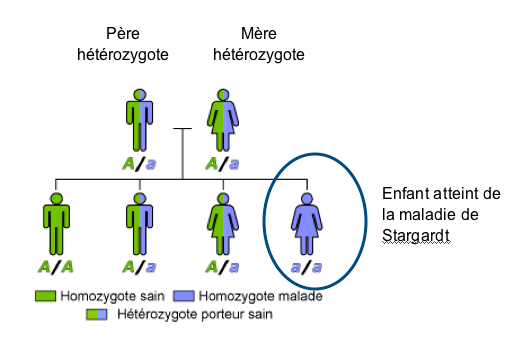Understanding genetic transmission of Stargardt disease
Stargardt disease is an autosomal recessive disorder, except for the form caused by the ELOV4 mutation.
What does this mean?
All genes exist in pairs. For each pair of genes, everybody inherits one gene from their father and one gene from their mother.
The usual form of Stargardt disease is an autosomal recessive disorder. This means that children having received the altered gene from both mother and father express the genetic trait of this disease.
The term “autosomal” means that the gene is located on a chromosome (autosome) that does not determine sex.
The term “recessive” means that the hereditary trait must be transmitted by both mother and father in order to be expressed. For the disease to be expressed, there must be the same mutation on both genes of the same pair. Patients are homozygous regarding the gene causing the disease, or homozygous for the disease.
Not all generations are affected by the disease, as most of the time, affected subjects have heterozygous parents, unaffected carriers (A/a).
Couples at risk are formed by two unaffected heterozygous carrier spouses (A/a).
Example of Stargardt disease’s autosomal recessive heredity :
According to Orphaschool: heredity of genetic diseases
http://www.orpha.net/orphaschool/formations/transmission/Ressources/2-AR/AR0.png
https://www.orpha.net/data/patho/Pub/fr/Stargardt-FRfrPub158v01.pdf
A: normal copy of the ABCA4 gene; a: mutated copy of the ABCA4 gene
A person is said to be homozygous if both copies of the gene within a pair are identical.
A person is said the be heterozygous if they carry either two copies of the gene each with different mutations or one modified and one normal copy of the gene.
- The child with the genotype a/a is an affected homozygote because she carries two copies of the gene with the same mutation. She is affected by Stargardt disease.
- The child with the genotype A/A is an unaffected homozygote because he carries identical normal copies of the gene on the pair of chromosomes. He is not ill and will not transmit the disease.
- The children with the genotype A/a are unaffected, heterozygous carriers. They each carry a normal copy and an altered copy of the gene. They are not ill but can transmit the disease.






